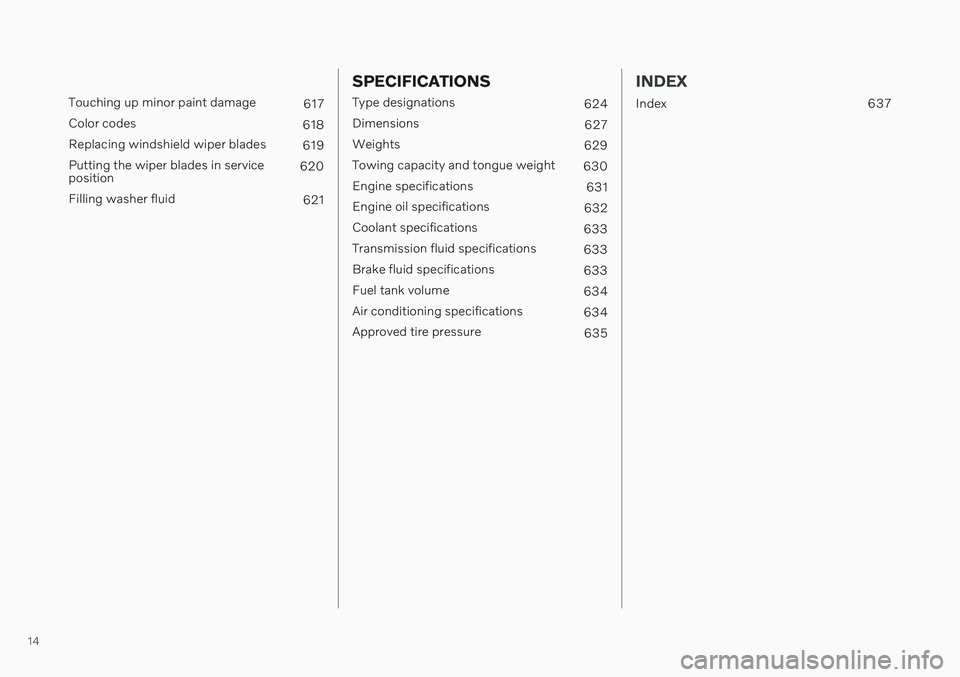coolant capacity VOLVO S60 TWIN ENGINE 2020 Owners Manual
[x] Cancel search | Manufacturer: VOLVO, Model Year: 2020, Model line: S60 TWIN ENGINE, Model: VOLVO S60 TWIN ENGINE 2020Pages: 657, PDF Size: 13.6 MB
Page 16 of 657

14
Touching up minor paint damage617
Color codes 618
Replacing windshield wiper blades 619
Putting the wiper blades in service position 620
Filling washer fluid 621
SPECIFICATIONS
Type designations624
Dimensions 627
Weights 629
Towing capacity and tongue weight 630
Engine specifications 631
Engine oil specifications 632
Coolant specifications 633
Transmission fluid specifications 633
Brake fluid specifications 633
Fuel tank volume 634
Air conditioning specifications 634
Approved tire pressure 635
INDEX
Index 637
Page 427 of 657

STARTING AND DRIVING
}}
* Option/accessory.425
Preparing for a long trip
It is important to have the vehicle's systems and equipment checked carefully before driv-ing long distances.
Check that
the engine is running properly and that fuel consumption is normal
there are no leaks (fuel, oil or other fluid)
the brake pedal is functioning properly
all lights are working
‒ adjust the head-
light height if the vehicle is carrying aheavy load
tire tread depth and air pressure are atcorrect levels. Change to snow tires whendriving in areas where there is a risk ofsnowy or icy roads
the start battery is sufficiently charged
the wiper blades are in good condition
Related information
Checking tire pressure (p. 525)
Filling washer fluid (p. 621)
Winter driving (p. 425)
Economical driving (p. 421)
Vehicle modem settings (p. 499)
Loading recommendations (p. 557)
Driving with a trailer (p. 436)
Pilot Assist
* (p. 279)
Tire sealing system (p. 541)
Winter driving
It is important to check the vehicle before driving in cold/snowy conditions to makesure it can be driven safely.
Before the cold season arrives: Make sure the engine coolant contains 50% antifreeze. This mixture helps pro-tect the engine from frost erosion down toapprox. –35 °C (–31 °F). Do not mix dif-ferent types of antifreeze as this couldpose a health risk.
Keep the fuel tank well filled to preventcondensation from forming.
Check the viscosity of the engine oil. Oilwith low viscosity (thinner oil) improvescold-weather starting and reduces fuelconsumption when driving with a coldengine.
CAUTION
Low-viscosity oil should not be used with hard driving or in hot weather.
Check the condition and charge level of the start battery. Cold weather placesgreater demands on the start battery andreduces its capacity.
Use washer fluid containing antifreeze tohelp prevent ice from forming in thewasher fluid reservoir.
Page 585 of 657

MAINTENANCE AND SERVICE
583
Hybrid battery The vehicle's electric motor is powered by a rechargeable, maintenance-free, lithium-ionhybrid battery.
NOTE
The vehicle cannot be started if the hybrid battery is discharged.
NOTE
If both the starter battery and the hybrid battery are discharged, both batteries
must be charged. In such cases, it is notpossible to charge only the hybrid batteryfirst. The starter battery must have a certain level of charge for it to be possible tocharge the hybrid battery.
WARNING
Hybrid battery replacement may only be performed by a workshop – an authorizedVolvo workshop is recommended.
CoolantThe hybrid battery's cooling system has its own expansion tank.
CAUTION
Filling the hybrid battery coolant should only be performed by a workshop – anauthorized Volvo workshop is recom-mended.
Specifications for hybrid batteryType: Lithium-ion
Power reserve: 11.6 kWh.
NOTE
The capacity of the hybrid battery decrea- ses with age and use, which could result inincreased use of the combustion engine,leading to higher fuel consumption andreduced electric motor range.
Related information
Battery symbols (p. 584)
Start battery (p. 579)
Charging the hybrid battery (p. 375)
Battery recycling (p. 584)
Page 643 of 657

INDEX
641
Driver performance 88
settings 89
Driver profile 133 edit 134, 135, 137
select 134
Driver support system 260 Drive mode 293
Drive systems 412 Driving cooling system 433
with a trailer 436
Driving economy 421
Driving through standing water 426driving with a trailer towball load 630
towing capacity 630
E
Economical driving 421
Electrical outlet 552use 554
Electrical system 579Electric drive motor specifications 631
electric motor 412Range 423
Electric parking brake 400
Electronic immobilizer 244
emergency brake lights 159
Emission inspection readiness 562Energy distribution using map data 418
Engine automatic start and stop of combus-
tion engine 413
overheating 433
start 392
turn off 394
Engine braking 397, 407 Engine compartment coolant 576
engine oil 574
overview 573
Engine drag control 261
Engine oil 574 filling 575
filter 574
grade and volume 632
Engine shutdown 394
Engine specifications 631Engine temperature high 433
Environment 28 Ethanol content max. 10% by volume 429
Exterior dimensions 627
Extra heater (Auxiliary heater) 227
F
Federal Clean Air Act 562
Ferry transport 419
Flooded road 426
Fluids, volumes 621, 634
Fluids and oils 633, 634Fog lights front 157
rear 158
Four-C 419 Front seat blower 216
climate 209
heating 210, 211
temperature 217
ventilation 211
Front seat manual 182